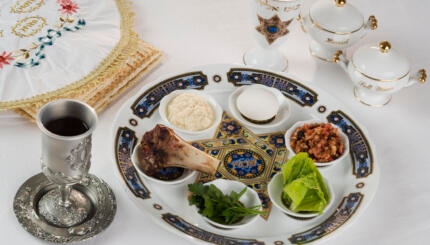I was five, perhaps six years old, when I found the matzah that my grandfather had placed in a linen napkin and hidden in the bedroom. I had glued my eyes on him from the moment he performed the yahatz ceremony, breaking the middle matzah into two unequal parts and replacing the smaller part in its original position. When he returned to the table, I looked forward to the search and retrieval. I knew, as did all my cousins around the table, that he who found the concealed larger part, the afikoman, could hold out for any prize.
That Passover night the seder ran exceptionally long and I was sleepy because of the cups of wine I had drunk and the lateness of the hour. I hid the napkin-covered matzah beneath the pillow of the bed and promptly fell into a deep sleep. I remember being roused by my mother who, with some urgency in her voice, insisted that I return the matzah so that the service could be completed. As I did so I sensed that this was no child’s play, that behind the hide-and-seek lay a more serious meaning. They were serious and I, who knew where the broken matzah was, held some true power in my hands.
Through the years I sensed more and more the mystery of the yahatz act. Every other ritual gesture was preceded by a benediction–over the wine, the washing of the hands, the parsley, the matzot, the bitter herbs mixed with haroset. But there was no berakhah [blessing] recited over the yahatz, not even an explanation such as the one given before eating the Hillel sandwich.
Rabbinic scholars sensed as well the oddity of reciting a motzi [blessing for bread] over a broken piece of unleavened bread; they wondered why the middle matzah and not the other two were broken, and why it was broken into two uneven parts with the larger part saved for the afikoman. Their explanations are largely legal, based upon the position of the Rambam, the Rif, and other sages. For others, the “stealing” of the afikomanwas designed to keep the children awake with play. But none of the explanations satisfied me. As in the case of opening the door for Elijah, I knew that more than the amusement of children was meant.

Help us keep Jewish knowledge accessible to millions of people around the world.
Your donation to My Jewish Learning fuels endless journeys of Jewish discovery. With your help, My Jewish Learning can continue to provide nonstop opportunities for learning, connection and growth.
Wanting Wholeness But Not Having It
In the outline of the seder ritual, the division of the middle matzah–yahatz–takes place early, before the great declaration, “This is the bread of affliction.” The eating of the retrieved matzah comes after ransoming it from the children at the end of the seder. The ritual of eating the afikoman is called tzafun, which means “hidden.” It, too, is eaten in silence, without benediction, before midnight. After the afikoman, no food or drink is to be taken except for the final two cups of wine. In some haggadot there is a devotional prayer in Aramaic that announces, “I am ready and prepared to perform the commandment of eating the afikoman to unite the Holy One blessed be He and His Divine Presence through the hidden and secret Guardian on behalf of all Israel.”
Brokenness is a symbol of incompletion. Life is not whole. The Passover itself is not complete. The Passover we celebrate deals with the past redemption of our people from the bondage in Egypt. That redemption is a fact of history and it heartens us because through its recollection we know that our hope for future redemption is not fantasy. It did happen once and to our whole people. A small slave people witnessed the power of a supreme divine agency to snap the heavy chains around our hands, and to break the yoke upon our necks. It was no dream, this redemption. It happened, and at the Seder we relate the testimony of this act.
But it is toward the Passover of the Future that our memories are directed. The redemption is not over. There is fear and poverty and sickness. There is a trembling on earth. Around us are the plagues of pollution, and images of fiery nuclear explosions in the clouds, not like the cloud of glory and the pillar of fire that led our ancestors through the wilderness. The broken matzah speaks to our times, shakes us by the shoulders and shouts into our hearts, “Do not bury your spirit in history. Do not think it is over, complete, that the Messiah has come and you have nothing to do but to wait, to pray, to believe.”
The Past and Present Tell Our Future
The history of our liberation is not for the sake of gloating over the past but for confirmation of our hopes. Even as we retrieve the past, the future is held before us. We begin the story of our past affliction with an appeal for present help and with aneye set upon the future. Three time dimensions are mentioned in one opening paragraph. “This is the bread of affliction that our ancestors ate in the land of Egypt. All who are hungry, let them come in an eat; all who are in need come in and celebrate the Passover. Now we are here, next year in Israel. Now we are subjects, next year may we be free persons.”
The silence before the breaking of the middle matzah and before the eating of the afikoman suggests that something secret is expressed in the ceremony. We know that the idea of a Messianic era was considered a threat to regimes for whom there was no messiah but the Emperor, no redeemer but Rome. To dream of an era of peace, an end to slavery, is a revolutionary critique of the status quo. Jews disagreed among themselves as to who the Messiah will be or when the Messiah will come, but one thing they all knew. This was not the Messiah, now was not the fulfillment of the Messianic era. In silence, without benediction–for one does not bless that which has not yet occurred–they broke the matzah hidden between the two whole ones, anticipated its recovery, and eating it affirmed their belief in the Passover of the Future.
The hidden matzah is the greater part. The promise of the future is greater than the achievements of the past. It is no game to keep the child awake, this secret. It is the vision of messianic times toward which we live and struggle. Rouse the child from his slumber. Without his find the seder cannot be completed.
Reprinted with permission of Sh’ma: A Journal of Jewish Responsibility, May 1986.


